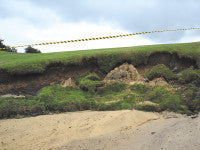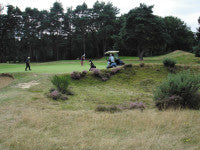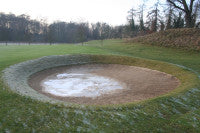Bunkers or bonkers?
 The majority of golfers would consider a course without bunkers to be inferior to those with. But is this the case? Are modern courses being built with bunkers just because it's the right thing to do rather than an important feature of the course? Jonathan Gaunt, Golf Course Architect and Senior Member of EIGCA, offers an insight into the history, design and maintenance of sand traps
The majority of golfers would consider a course without bunkers to be inferior to those with. But is this the case? Are modern courses being built with bunkers just because it's the right thing to do rather than an important feature of the course? Jonathan Gaunt, Golf Course Architect and Senior Member of EIGCA, offers an insight into the history, design and maintenance of sand traps
If you ask a club member in the UK whether a golf course could be considered a good golf course without bunkers, the majority would, almost certainly, say no.
However, there are some excellent (hidden) examples of great golf courses without bunkers - Huntercombe, Royal Ashdown and Piltdown to name but a few - where other hazards, such as heather, grassy hollows and ditches work equally well as protection from attack.
These courses though are in the minority and, in general terms, golf courses with bunkers are considered much more fun to play. There are links courses with literally, hundreds of bunkers - at Muirfield or Royal Lytham & St Annes, for example. Many of them are 'pot' bunkers which are deep and penal. Many new golf courses are scattered with bunkers. Some are excessive in size - 'waste bunkers' such as those at The Oxfordshire, and clusters of bunkers, such as Chart Hills, which are often considered more than would normally be appropriate. This all adds to maintenance costs but, also influential in this respect, is the shape and style of bunker.
The sand bunker originally developed on early links golf courses in hollows in the dunes, protected from the wind, in which sheep and rabbits sheltered. Inevitably, the grass in these hollows would be nibbled away and then the ground scraped by their feet leaving sandy scrapes. These became excellent hazards and it is this humble feature that has been replicated throughout the world (in many shapes and forms) on thousands of golf courses. On links courses these sandy scrapes eventually developed into 'revetted' bunkers, using turf to create a pretty strong retaining wall. The resulting bunkers - St Andrews, Old Course, for example - are sometimes impossible to play out of in a forward direction. Some may consider this unfair, but it is considered to be a natural characteristic of links courses.
In the latter part of the 19th century and early 20th century golf courses were being built at a great rate in the UK and the USA. Unfortunately, in many cases, the bunker was used more as an obstruction than a hazard, with ugly rampart-like features being created to catch the low-running ball. Many of these features still remain today on some of the older courses. These obstructions, at between 100 and 200 yards from the tee, often went from one side of the fairway to the other!
Thankfully, inspirational golf architects such as Harry Colt, Willie Park Jnr. and Alister MacKenzie soon realised that the placement and shaping of these hazards required more careful thought and subtlety, which would soon begin to influence the game of golf dramatically, for the better.
Whether the architect is Park, MacKenzie or Colt, the same is true - that all features throughout the design of each hole relate back from green to tee, rather than forwards from tee to green. The way in which the green is protected by bunkers, grassy hollows, mounding, water hazards, etc., directly influences the approach shot into the green. Moreover, the position that the approach shot is played from affects the drive and the choice of club - wood, long iron, etc. - to be played from the tee.
Bunkering and featuring at the landing area impacts directly upon whether the golfer wants to take on more or less of a risk - the choice determines how difficult the approach shot into the green will be. The greater the risk the greater the reward.
While Willie Park Jnr. and Harry Colt were transforming the placement of bunkers, and their influence upon the design of golf courses, Alister Mackenzie was refining the shaping and style of bunkers themselves. The 'lace-wing' style, still visible on some bunkers at Headingley and Harrogate Golf Clubs in Yorkshire, which he developed and used successfully at numerous golf courses throughout the UK and USA, was revolutionary (if a little more difficult to maintain). These bunkers soon settled into their location and had a more natural character, moving away from the more maintained style being developed by not just Park and Colt, but by John Abercromby (at Worplesdon) and Tom Simpson (at Chantilly and Morfontaine, both near Paris).
MacKenzie went on to design memorable golf courses in the USA - Crystal Downs, Cypress Point, Pasatiempo (Mexico) and, most famously, Augusta National. Sadly, the bunkers at Augusta have been tampered with by numerous golf course architects over the years, mainly Trent Jones, and the only one remaining that looks remotely like MacKenzie's style is on the 10th fairway, but it is now pretty redundant in playing terms, being as it is mid-point between fairway landing area and the green.
In general, there are many bunkers throughout the world that fail to provide a suitable and relevant hazard for a number of reasons. This may be because the placement is not correct in relation to distance from the tee, line of approach, slope of the fairway/landing area, visibility, fairness, challenge, etc. the list goes on ...
The reason why bunkers don't achieve their true potential can also be due to poor maintenance, and the difficulty of maintaining a good grass and/or heather sward on the surrounds, slopes and banking. In general terms, the sand faces advance forward into the mounds they have been built into, due to the way golfers play from them, normally with a sand iron, eventually creating a steep face with a cliff or lip at the apex of the mound. Where there are also drainage problems, and where sandy soil sits on top of clay, the entire bunker face can collapse following heavy rain.
On many inland courses, bunkers have previously, and inappropriately, been revetted, which has created specific problems. These bunkers are notoriously difficult to maintain and can very quickly deteriorate and look unsightly, especially on exposed sites. On links courses these bunkers sometimes need to be replaced or renovated every two to three years.
 Also, because of the effects of erosion by the elements, golfers' feet and maintenance vehicles, the bunker lips collapse, creating, in some cases, unplayable lies. As greenside bunkers advance towards the green and the faces wear away, the size of the green aprons reduces, restricting access to golfers and, more importantly, to maintenance equipment around the greens. This eventually results in a considerable reduction in the size of the greens themselves. Where greens are already small this is unacceptable, creating further wear problems on the putting surface.
Also, because of the effects of erosion by the elements, golfers' feet and maintenance vehicles, the bunker lips collapse, creating, in some cases, unplayable lies. As greenside bunkers advance towards the green and the faces wear away, the size of the green aprons reduces, restricting access to golfers and, more importantly, to maintenance equipment around the greens. This eventually results in a considerable reduction in the size of the greens themselves. Where greens are already small this is unacceptable, creating further wear problems on the putting surface.
At the same time, the aprons immediately adjacent to the bunkers wear away with little grass cover or, in some places, none at all. The shape and close proximity of the greenside bunkers encourages sandsplash onto the apron. Over the years the sand builds up to such an extent that the topsoil is buried, creating a very sandy, drought-prone and hostile growing environment for the grass. This dries out more readily in summer and, in wetter conditions, encouraging moss and weeds to grow. Even if grass does begin to establish, the sandsplash would continue to restrict its growth under constant build up from golfers.
Bunkers degrade over the years, not necessarily due to poor management, but to a number of factors; possibly a poor original shape or a bad location. Add to this a higher number of golfers now playing the game and the increased general wear associated with the playing of bunker shots. When thousands of shots are played from a bunker, this will inevitably lead to a change in the character of the bunker shape and this problem worsens over the years.
Due to the distances that golfers are now able to hit a golf ball there are many bunkers that have become redundant and contribute little to the playability or challenge of the course. This may provide potential for the construction of new, well-placed fairway bunkers, which would make the courses considerably more testing to play.
On some heathland and moorland courses, heather growth on the bunker banks and surrounds gives them a very attractive look, but makes them difficult to maintain in a neat and tidy state and sometimes creates ruling problems - i.e. is the ball in the bunker or not when it is sitting in overhanging heather?
In relation to a bunker reconstruction and/or renovation programme, where greenside bunkers are still influential to play, they should be retained but it is advisable to rebuild them further way from the putting surfaces to enable better access for maintenance machinery and foot traffic. This will also enable the greenkeeper to spread wear and minimise the build up of bunker sand. Some greenside bunkers, though, could be more effective reshaped as grassy hollows.
Golf courses are now put under a greater pressure due to increased numbers of golfers. The balance, though, is disproportionate because the greens and surrounds have remained the same size (or even got smaller in some cases).
With some bunkers, the edges furthest from the greens (the front edge) build up due to erosion caused mainly by water washing sand across the bunker surface to the point where there is now actually a rise or small incline running into the bunker (of up to 200mm high in places). This creates a raised feature whose function is contrary to that which is intended - a bunker should be a hollow, designed to 'trap' the ball - it should be a depression which the ball easily rolls into. The collection area should extend outside the sand area so that a ball within a few metres may well still end up in the sand - this design feature is very evident on most links courses.
Another associated problem is compaction of sand in the bunker base. This can be attributed to the kind of sand that has been used and contamination with the (clay) soil beneath. It is also due to saturation of sand, either because there is no drainage, or any drains that might have existed have been capped off or become blocked over time. When heavy rain falls, during extreme storms, the sand often ends up being washed off the faces and the water has nowhere to drain away to, so it takes the sand with it.
The most important point to consider about a bunker renovation programme is the style to go with. Whichever style is chosen there must be consistency throughout, in relation to the visual look of the bunkers, their playability, their maintainability and their appropriateness in relation to the history of the course.
At West Hill, following my advice, the club chose the turf-topped bunker with heather sods (imported from Hankley Common Golf Club) incorporated into banks of the approach and fairway bunkers. The smooth-shaped bunker banks were inspired by the original designs of Willie Park Jnr. and Harry Colt, which were illustrated on original photographs of the course. This style has worked particularly well in playing, visual and maintenance terms.
At Worplesdon, the club chose a higher sand-faced bunker, which they considered to be more in keeping with the design style of John Abercromby, the original golf course architect. Also, because the work was considered to be more of a restoration programme than renovation. Heather was again used on the bunker banks, but the club decided to use pot planted heather plants instead of sods and they did not establish well. Also, the bunker banks were much steeper, making establishment more difficult. Visually, however, they do look very impressive.
In all cases, where reshaping is to be undertaken, the bunker banks and bases must be shaped to be a gentle (concave) grade and then drained. Generally, a shallow drainage trench would be excavated in the lowest point in each bunker, creating a number of spurs, which will link into a main outfall drain, excavated at the lowest point. Perforated drainage pipe would be installed in each trench and then backfilled to the surface with gravel, finished off with geotextile membrane over the trench only. Topsoil can then be spread on the surrounds and turf laid. The bunker drain would be connected up with the existing fairway drainage system or adjacent ditch.
All bunker bases would be firmly tamped down or rolled smooth prior to any sand placement. When stones or flint are present either a geotextile membrane or suitable clay can be laid over the bunker base or upturned, downgraded turves, to prevent stones coming to the surface.
The actual sand area of the bunker will be determined once the turf is established. Where the bunker is an essential visual hazard the sand must be visible from the tee or the fairway, as appropriate. Generally, the faces of the new bunkers will be turfed to the point at which sand can be raked up to meet it, without washing back down to the base of the bunker after every rainstorm.
It is possible to use a mechanical bunker rake in most new bunkers, or a combination of machine and hand-raking where sand is required to be raked partially up the faces. The surrounds will be significantly easier to mechanically mow because of the smooth grades and slopes.
It should become an essential part of the general maintenance procedures to ensure that sandsplash is brushed away from bunker banks and green aprons, as a matter of course. It will also be necessary to regularly aerate the bunker surrounds (Vertidrain, or similar), and to topdress, fertilise and overseed, when necessary, to maintain a good healthy grass sward. It will be this grass cover that will prevent establishment and wear problems re-occurring.
A bunker renovation and remodeling programme can give any course a facelift and bring it forward into the 21st century. The courses at West Hill and Worplesdon were both already fundamentally very good, but the bunkers needed attention in order for them to really 'show their teeth' and achieve their true potential as two of the best courses in Surrey. This has been achieved to the satisfaction of the committee, members and consulting golf course architect.
